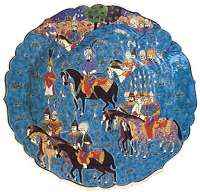Anatolian Turkish Ceramic Tiles and Pottery
 The potteries in Turkey have their origins in Phrygian times.
For thousands of years the local clay has been shaped and decorated into objects both
utilitarian and beautiful. Their designs reflect the legacy of the numerous civilizations.
Today many of the potteries still use traditional methods and tools. The potteries in Turkey have their origins in Phrygian times.
For thousands of years the local clay has been shaped and decorated into objects both
utilitarian and beautiful. Their designs reflect the legacy of the numerous civilizations.
Today many of the potteries still use traditional methods and tools.
As the forebears have done for centuries, potters continue to prepare the
clay, give it shape, fire it, glaze and paint it. First the mixture of clay and kaolin is
sieved, then ground into a fine paste. It is then left to rest in tanks, pressed through
rollers, and then rests again for a week to ten days to leaven. The result is
clay with a pliable texture which responds to the hands of the potters. The potters
wheels begin to whirl one by one and you can watch the dance of the clay as it narrows
into graceful necks, swells and deflates like a balloon, and rises into tapering shapes.
Deftly and gently the potters transform the clay into the objects devised in their
imagination.
 The
pots are left to dry out before firing in a kiln at 950º C. Next any flaws and rough
edges are sanded down and they are taken to the decoration room. Here the decorators, most
of them girl trainees, paint the patterns onto each piece, supervised by master decorators
who check new designs and correct any mistakes. The young decorators work with skilled
hands, pouring their hearts into the intricate designs. Most of them have acquired enough
experience to paint without reference to the drawn patterns. When they have finished each
piece they sign them with the words, This was painted by and their name. Each
piece is then dipped into the tank of glaze the consistency of honey and fired for a
second time at 830-880º C. Then the decorators wait expectantly to see the finished
result, because the signature ensures that any faults or careless work can be traced to
the person responsible. In the packaging department the foreman quickly separates the
pieces into groups belonging to each decorator. The
pots are left to dry out before firing in a kiln at 950º C. Next any flaws and rough
edges are sanded down and they are taken to the decoration room. Here the decorators, most
of them girl trainees, paint the patterns onto each piece, supervised by master decorators
who check new designs and correct any mistakes. The young decorators work with skilled
hands, pouring their hearts into the intricate designs. Most of them have acquired enough
experience to paint without reference to the drawn patterns. When they have finished each
piece they sign them with the words, This was painted by and their name. Each
piece is then dipped into the tank of glaze the consistency of honey and fired for a
second time at 830-880º C. Then the decorators wait expectantly to see the finished
result, because the signature ensures that any faults or careless work can be traced to
the person responsible. In the packaging department the foreman quickly separates the
pieces into groups belonging to each decorator.
- Source:
- Küyahya - A town where clay takes on a myriad shapes and
patterns
- Erdal Yazıcı
SKYLIFE 11/98
|